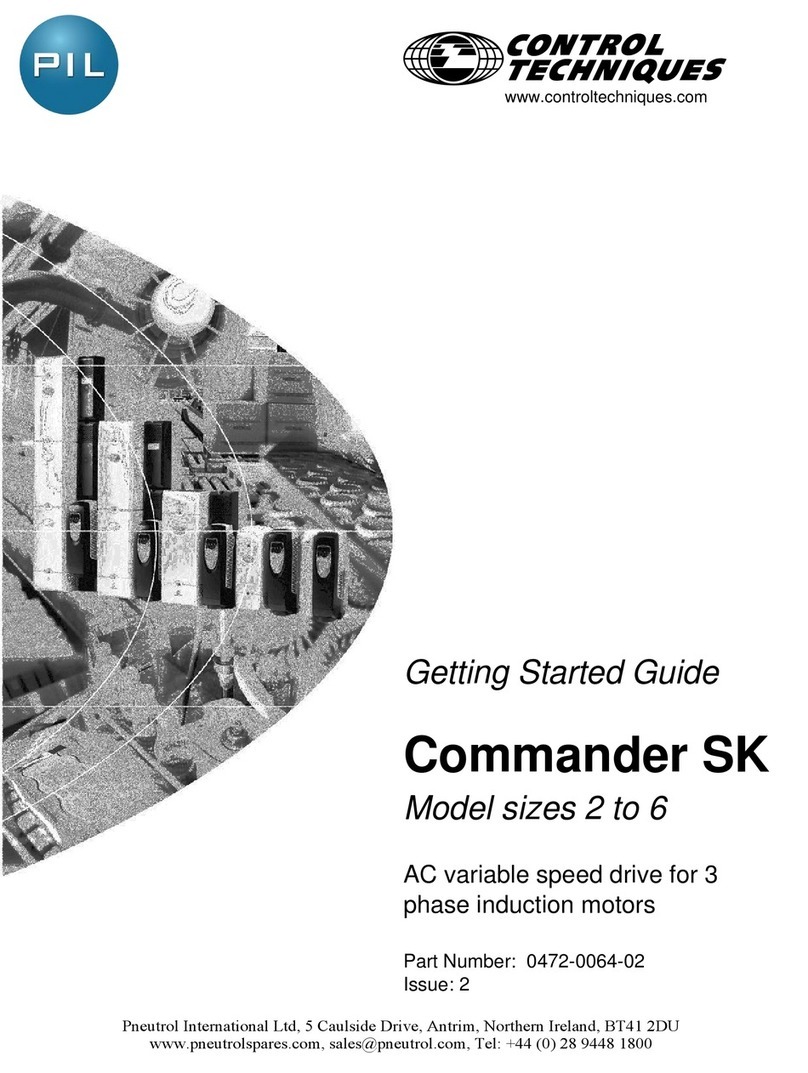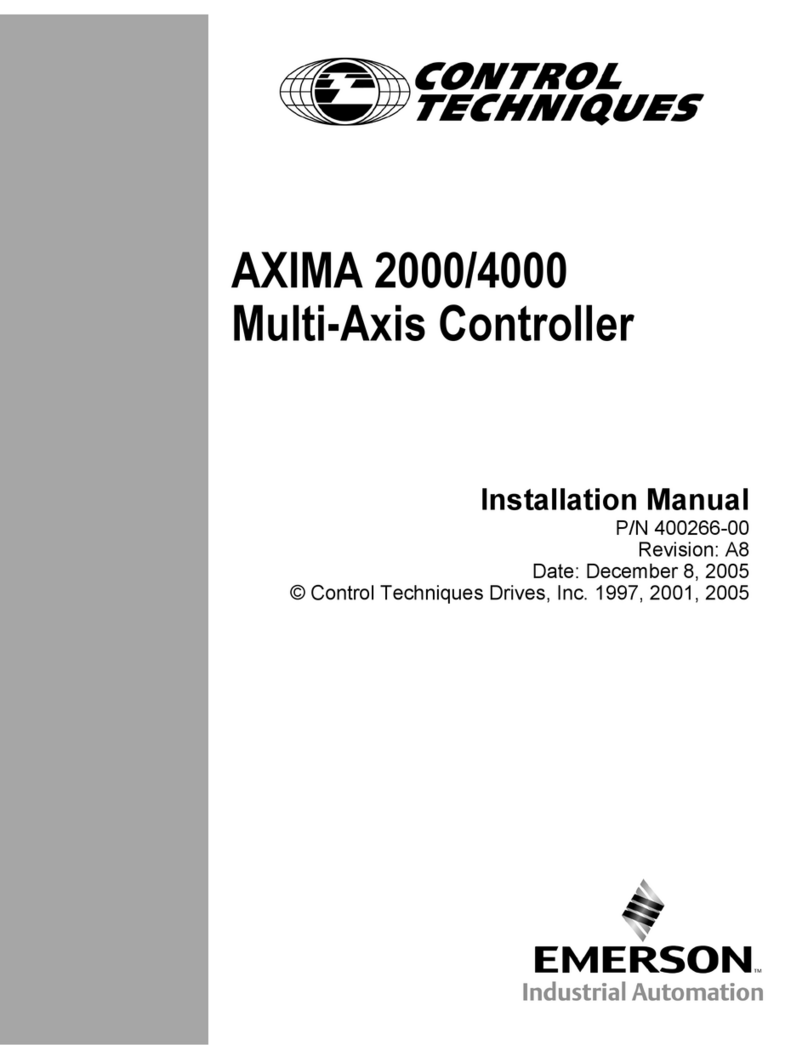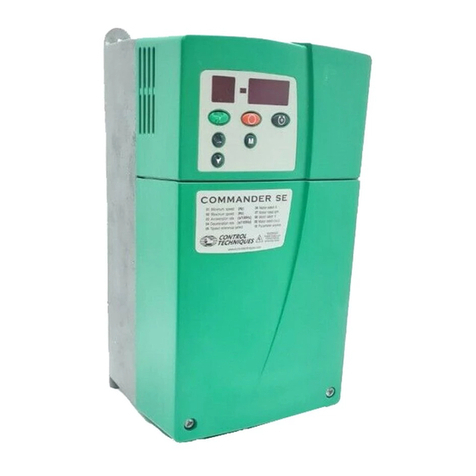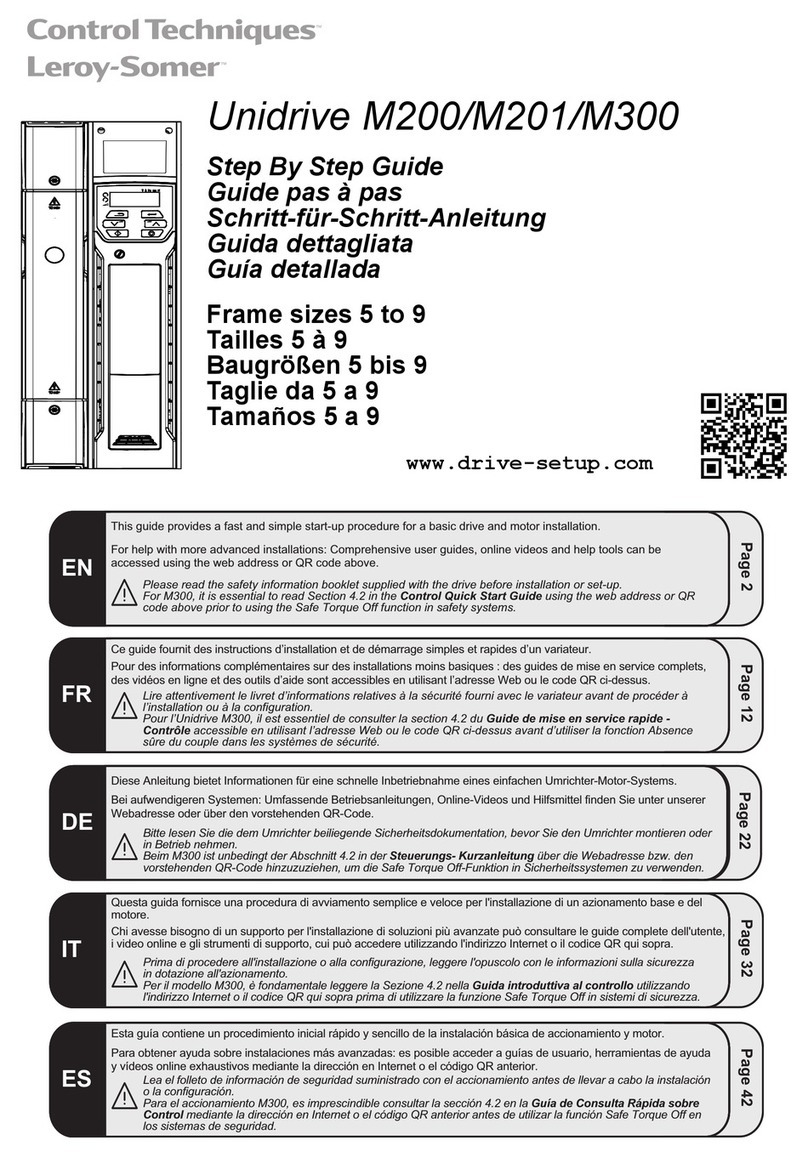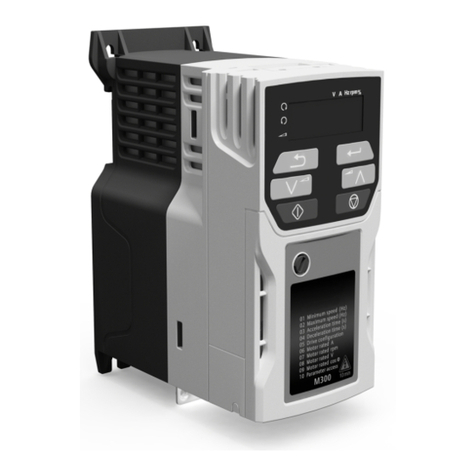
Parameter
structure
Keypad and
display Parameter x.00 Parameter
description format
Advanced parameter
descriptions
Macros Serial comms
protocol
Electronic
nameplate Performance Feature look-
up table
6Unidrive SP Advanced User Guide
www.controltechniques.com Issue Number: 7
Table 1-1 Menu 0 parameters
Parameter Range(Ú) Default(Ö)Type
OL VT SV OL VT SV
0.00 xx.00 {x.00} 0 to 32,767 0 RW Uni
0.01 Minimum reference clamp {1.07}±3,000.0Hz ±Speed_limit_max rpm 0.0 RW Bi PT US
0.02 Maximum reference clamp {1.06} 0 to 3,000.0Hz Speed_limit_max rpm EUR> 50.0
USA> 60.0
EUR> 1,500.0
USA> 1800.0 3,000.0 RW Uni US
0.03 Acceleration rate {2.11} 0.0 to 3,200.0
s/100Hz
0.000 to 3,200.000
s/1,000rpm 5.0 2.000 0.0200 RW Uni US
0.04 Deceleration rate {2.21}0.0 to 3,200.0
s/100Hz
0.000 to 3,200.000
s/1,000rpm 10.0 2.000 0.0200 RW Uni US
0.05 Reference select {1.14}A1.A2 (0), A1.Pr (1), A2.Pr (2), Pr (3), Pad (4),
Prc (5) A1.A2 (0) RW Txt NC US
0.06 Current limit {4.07} 0 to Current_limit_max % 165.0 175.0 RW Uni RA US
0.07 OL> Voltage mode select {5.14}
Ur_S (0),
Ur (1), Fd (2),
Ur_Auto (3),
Ur_I (4),
SrE (5)
Ur_I (4) RW Txt US
CL> Speed controller P gain {3.10} 0.0000 to 6.5535 1/rad s-1 0.0100 RW Uni US
0.08 OL> Voltage boost {5.15}
0.0 to 25.0%
of motor rated
voltage
3.0 RW Uni US
CL> Speed controller I gain {3.11}0.00 to 655.35 1/rad 1.00 RW Uni US
0.09 OL> Dynamic V/F {5.13}OFF (0) or On
(1) 0RW Bit US
CL> Speed controller D gain {3.12}0.00000 to 0.65535 (s) 0.00000 RW Uni US
0.10 OL> Estimated motor speed {5.04} ±180,000 rpm RO Bi FI NC PT
CL> Motor speed {3.02}±Speed_max rpm RO Bi FI NC PT
0.11
OL & VT> Drive output
frequency {5.01} ±Speed_freq_max Hz RO Bi FI NC PT
SV> Drive encoder position {3.29}
0 to 65,535
1/216ths of a
revolution
RO Uni FI NC PT
0.12 Total motor current {4.01} 0 to Drive_current_max A RO Uni FI NC PT
0.13
OL & VT> Motor active
current {4.02} ±Drive_current_max A RO Bi FI NC PT
SV> Analog input 1 offset trim {7.07}±10.000 % 0.000 RW Bi US
0.14 Torque mode selector {4.11} 0 to 1 0 to 4 Speed control mode (0) RW Uni US
0.15 Ramp mode select {2.04}
FASt (0)
Std (1)
Std.hV (2)
FASt (0)
Std (1) Std (1) RW Txt US
0.16
OL> T28 and T29 auto-
selection disable {8.39}OFF (0) or On
(1) 0RW Bit US
CL> Ramp enable {2.02}OFF (0) or On (1) On (1) RW Bit US
0.17
OL> T29 digital input
destination {8.26}Pr 0.00 to
Pr 21.51 Pr 6.31 RW Uni DE PT US
CL> Current demand filter
time constant {4.12}0.0 to 25.0 ms 0.0 RW Uni US
0.18 Positive logic select {8.29} OFF (0) or On (1) On (1) RW Bit PT US
0.19 Analog input 2 mode {7.11}0-20 (0), 20-0 (1), 4-20tr (2), 20-4tr (3),
4-20 (4), 20-4 (5), VOLt (6) VOLt (6) RW Txt US
0.20 Analog input 2 destination {7.14}Pr0.00 to Pr 21.51 Pr 1.37 RW Uni DE PT US
0.21 Analog input 3 mode {7.15}
0-20 (0), 20-0 (1), 4-20tr (2), 20-4tr (3),
4-20 (4), 20-4 (5), VOLt (6), th.SC (7),
th (8), th.diSp (9)
VOLt (6) RW Txt PT US
0.22 Bipolar reference select {1.10} OFF (0) or On (1) OFF (0) RW Bit US
0.23 Jog reference {1.05} 0 to 400.0 Hz 0 to 4000.0 rpm 0.0 RW Uni US
0.24 Pre-set reference 1 {1.21} ±Speed_limit_max rpm 0.0 RW Bi US
0.25 Pre-set reference 2 {1.22} ±Speed_limit_max rpm 0.0 RW Bi US
0.26 OL> Pre-set reference 3 {1.23}±Speed_freq_
max Hz/rpm 0.0 RW Bi US
CL> Overspeed threshold {3.08}0 to 40,000 rpm 0RWUni US
0.27
OL> Pre-set reference 4 {1.24}±Speed_freq_
max Hz/rpm 0.0 RW Bi US
CL> Drive encoder lines per
revolution {3.34}0 to 50,000 1024 4096 RW Uni US
0.28 Keypad fwd/rev key enable {6.13} OFF (0) or On (1) OFF (0) RW Bit US
0.29 SMARTCARD parameter
data {11.36} 0 to 999 0 RO Uni NC PT US
0.30 Parameter cloning {11.42} nonE (0), rEAd (1), Prog (2), AutO (3), boot (4) nonE (0) RW Txt NC *
0.31 Drive rated voltage {11.33} 200 (0), 400 (1), 575 (2), 690 (3) V RO Txt NC PT
http://nicontrols.com
